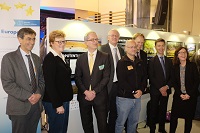This week the Horizon 2020 ECOPOTENTIAL project launched an interesting photo exhibition in the premises of the European Parliament.
The event was hosted by MEP Monika Hohlmeier who is the Vice-Chair of the Budget Committee, and Chair of the “Sky and Space” Intergroup at the European Parliament.
Monika Hohlmeier and Kurt Vandhenberge, Director at the European Commission, gave inspiring opening speeches, where they insisted on the crucial importance of protected areas such as national and regional parks. These are a mainstay of biodiversity conservation, while also contributing to people’s livelihoods, particularly at the local level. Furthermore, they contribute to mitigate the impact of climate change: it has been estimated that the global network of protected areas stores at least 15% of terrestrial carbon.
Monika Hohlmeier and Kurt Vandhenberge underlined the key role of research to monitor, understand and predict the ecosystems changes occurring in these areas. They also reiterated their full support to successful EU programmes such as Horizon 2020, Copernicus and the Life programme.
They both acknowledged the importance of research projects such as ECOPOTENTIAL, most notably in delivering concrete results not only for users at local level in Europe, but also for society and decision makers.
Antonello Provenzale and Carl Beierkuhnlein, the ECOPOTENTIAL project coordinators, explained that Europe invest a significant amount of money in Earth observation (space and in situ) as well as in protection of pristine areas. It appears logical, then, to support research aiming at obtaining concrete services from these investments.
In this context, the ECOPOTENTIAL project promotes the use of satellite data made available through Copernicus, as well as of field measurements, to understand and monitor changes in ecosystems and support the effective management of protected areas.
Building on the knowledge gained in individual protected areas, ECOPOTENTIAL addresses cross-scale ecological and environmental interactions from local to continental scales. All data, model results and acquired knowledge is made available on common and open platforms, contributing to the Global Earth Observation System of Systems (GEOSS). ECOPOTENTIAL is also actively following the developments of the EUROGEOSS initiative launched in 2017.
The exhibition displays 23 panels, in addition to two general panels, which tell the story behind each of the protected areas inside and outside Europe, and it will be again on display, at the Committee of the Regions, from the end of January. The panels give concrete examples of how satellites and in situ data can be used as relevant source of information for the concrete needs of park managers. For instance, Felix Medina, staff representative of El Cabildo de La Palma - one of the protected areas in the project - explained that “invasive species and forest fires are threatening the island ecosystem. ECOPOTENTIAL and the use of remote sensing tools have allowed us to better understand the spread of species and forest fires, which is important to conserve our unique ecosystems".
